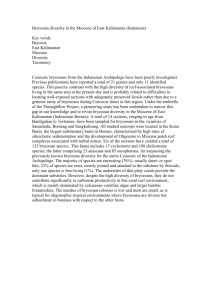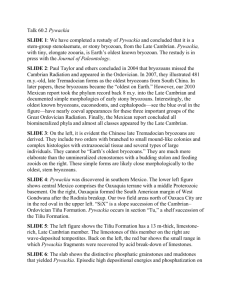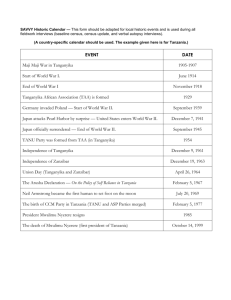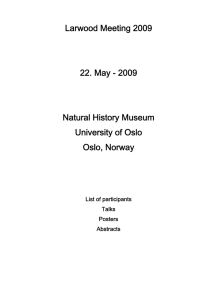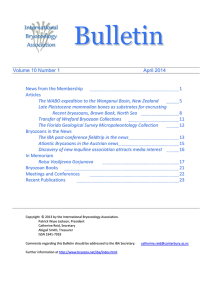Cryptic Creepers – A diversity study of encrusting bryozoans in... Student: Kimberly Smith
advertisement
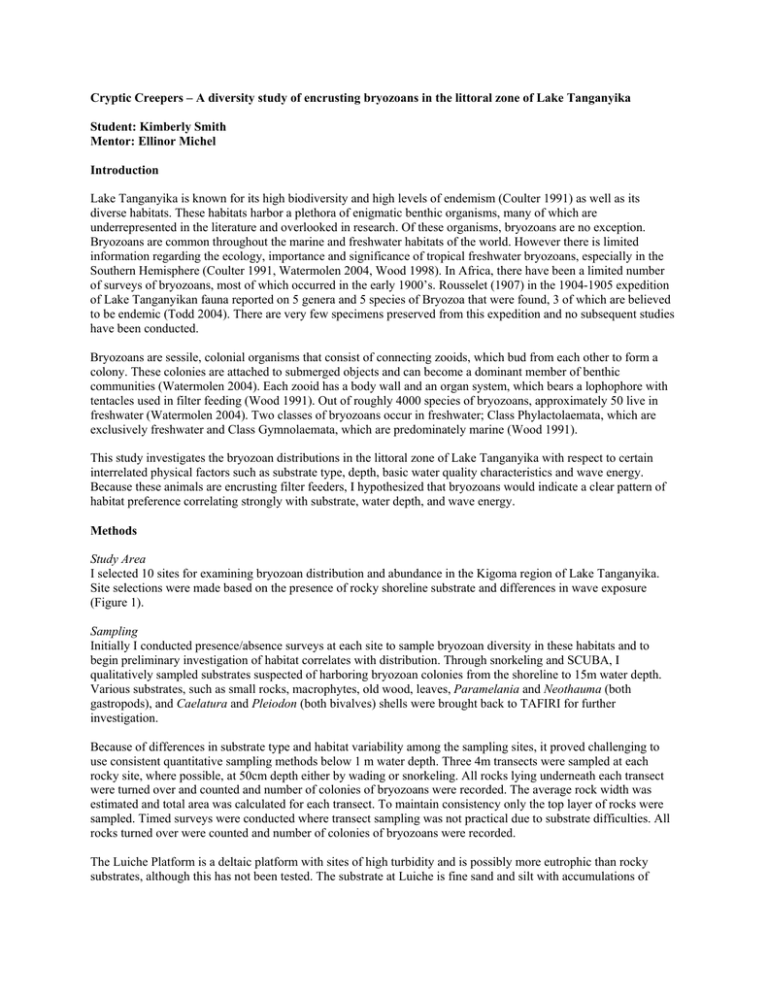
Cryptic Creepers – A diversity study of encrusting bryozoans in the littoral zone of Lake Tanganyika Student: Kimberly Smith Mentor: Ellinor Michel Introduction Lake Tanganyika is known for its high biodiversity and high levels of endemism (Coulter 1991) as well as its diverse habitats. These habitats harbor a plethora of enigmatic benthic organisms, many of which are underrepresented in the literature and overlooked in research. Of these organisms, bryozoans are no exception. Bryozoans are common throughout the marine and freshwater habitats of the world. However there is limited information regarding the ecology, importance and significance of tropical freshwater bryozoans, especially in the Southern Hemisphere (Coulter 1991, Watermolen 2004, Wood 1998). In Africa, there have been a limited number of surveys of bryozoans, most of which occurred in the early 1900’s. Rousselet (1907) in the 1904-1905 expedition of Lake Tanganyikan fauna reported on 5 genera and 5 species of Bryozoa that were found, 3 of which are believed to be endemic (Todd 2004). There are very few specimens preserved from this expedition and no subsequent studies have been conducted. Bryozoans are sessile, colonial organisms that consist of connecting zooids, which bud from each other to form a colony. These colonies are attached to submerged objects and can become a dominant member of benthic communities (Watermolen 2004). Each zooid has a body wall and an organ system, which bears a lophophore with tentacles used in filter feeding (Wood 1991). Out of roughly 4000 species of bryozoans, approximately 50 live in freshwater (Watermolen 2004). Two classes of bryozoans occur in freshwater; Class Phylactolaemata, which are exclusively freshwater and Class Gymnolaemata, which are predominately marine (Wood 1991). This study investigates the bryozoan distributions in the littoral zone of Lake Tanganyika with respect to certain interrelated physical factors such as substrate type, depth, basic water quality characteristics and wave energy. Because these animals are encrusting filter feeders, I hypothesized that bryozoans would indicate a clear pattern of habitat preference correlating strongly with substrate, water depth, and wave energy. Methods Study Area I selected 10 sites for examining bryozoan distribution and abundance in the Kigoma region of Lake Tanganyika. Site selections were made based on the presence of rocky shoreline substrate and differences in wave exposure (Figure 1). Sampling Initially I conducted presence/absence surveys at each site to sample bryozoan diversity in these habitats and to begin preliminary investigation of habitat correlates with distribution. Through snorkeling and SCUBA, I qualitatively sampled substrates suspected of harboring bryozoan colonies from the shoreline to 15m water depth. Various substrates, such as small rocks, macrophytes, old wood, leaves, Paramelania and Neothauma (both gastropods), and Caelatura and Pleiodon (both bivalves) shells were brought back to TAFIRI for further investigation. Because of differences in substrate type and habitat variability among the sampling sites, it proved challenging to use consistent quantitative sampling methods below 1 m water depth. Three 4m transects were sampled at each rocky site, where possible, at 50cm depth either by wading or snorkeling. All rocks lying underneath each transect were turned over and counted and number of colonies of bryozoans were recorded. The average rock width was estimated and total area was calculated for each transect. To maintain consistency only the top layer of rocks were sampled. Timed surveys were conducted where transect sampling was not practical due to substrate difficulties. All rocks turned over were counted and number of colonies of bryozoans were recorded. The Luiche Platform is a deltaic platform with sites of high turbidity and is possibly more eutrophic than rocky substrates, although this has not been tested. The substrate at Luiche is fine sand and silt with accumulations of Neothauma shells and other small mollusk shells. Because the sampling sites were flat and the abundance of bryozoans during the qualitative survey was high it seemed appropriate to use quadrats as the transect method might not accurately capture true abundance. Both sites at the Luiche Platform were sampled using a 40cm x 40cm quadrat with three replications at each site. All substrate at each site was brought back to TAFIRI for inspection. Specimens were brought back to TAFIRI for identification and preservation. All specimens were preserved in 99% ethanol. Slides were made of at least one specimen from each site and photographs were taken. Wave energy was measured at each site using Doty’s (1971) clod card technique. Exact methods used are also described in Weier (this volume). Wave energy was ranked 1-8 from least energy to greatest energy for analyses. Results Bryozoans were found at 9 out the 10 sites sampled (Fig. 1 and Table 1). Phylactolaemates were observed at all 9 sites and gymnolaemates were observed at 4 sites. Four genera and 4 species were identified, 2 of which are endemic (Table 1). Fredericella cunningtoni and Arachnoidea raylankesteri Moore are both endemic (Rousselet 1907). Diversity surveys discovered an unidentified Victorella (?) sp. at 2 sites. This seems to be the first record of this probably undescribed species in Lake Tanganyika. The majority of cobbles with colonies attached were relatively smooth and characteristic of granitic or sandstone conglomerates. Most bryozoans were observed underneath small to medium cobbles in 20-100cm of water, with the exception of the Luiche Platform, where they were at 10m depth. Most colonies at Luiche were found on dead Neothauma shells with a few colonies on Caelatura shells. Bryozoans were not discovered at depths or on certain substrates previously described (Rousselet 1907, Todd in correspondence), such as macrophytes, Paramelania shells, or old wood from 10-20m. No clear correlation exists between wave energy and habitat preference (Figure 1). However there appears to be a trend in distribution comparing wave energy to total number of colonies per area (Figure 2). Area could not be calculated at every site given differences in sampling methods. Water quality variables were not taken. We also observed unique and undescribed interactions between sponges, phylactolaemates and gymnolaemates. Phlyactolaemates were observed growing on top of and directly next to sponges, whereas the sponges were observed growing over the bryozoans. Gymnolaemates were also observed growing right up to the edges of sponges. Both organisms were alive in all cases and appeared to be undisturbed by these interactions. Zooidal polarity reversal and zooidal polarity loss were both observed in several specimens of Arachnoidea raylankesteri Moore, which is only known to occur in marine species of Arachnidium. Zooidal polarity reversal occurs when one zooid in the colony switches direction of growth so that its body is facing the opposite direction to all the other zooids. Zooidal polarity loss occurs when the peristome of the zooid does not align with the cauda of the zooid but instead is off-center and leaning to one side of the body wall. Discussion It is interesting to note that bryozoans were observed at 90% of the sites. It is also important to recognize that they were not on specific substrates previously described such as Paramelania shells, macrophytes, and old sunken wood and leaves or at depths of 15-20m as previously described. There appears to be various scales of patchiness associated with bryozoans. It is very likely that these organisms are on these substrates and at depth but were just overlooked or undersampled. If their absence is correct, this could indicate temporal instability. Most temperate bryozoans are known to have several generations throughout the “growing season” and go through a period of dormancy in the winter (Wood 1991). Phylactolaemates use reproductive structures called statoblasts, which are encapsulated dormant buds that can overwinter and allow a new colony to form (Wood 1991, Jones et al. 2000). In tropical bryozoans, statoblasts are produced to survive dry seasons (Jones et al. 2000). It could be possible that previous studies were conducted at different times of the year, which could explain this discrepancy as well. Zooidal polarity loss was observed in Arachnoidea raylankesteri Moore sampled at Luiche Platform. Arachnoidea was first found and described in Lake Tanganyika by Moore in the late 1800’s and found again during the 19041905 expedition (Rousselet 1907). It is a genus endemic to Lake Tanganyika and closely resembles the marine genus Arachnidium, which lends further support for marine linkages. Moore (1898) brought to our attention the possibility of marine convergence within the cnidarian, molluscan, poriferan, and arthropod phyla at Lake Tanganyika and later wrote a book “The Tanganyika Problem” (Moore 1903) which includes Arachnoidea raylankesteri Moore as a key organism. Zooidal polarity loss is well documented among the marine Arachnidium but has never been observed in freshwater gymnolaemates (Todd, pers. comm.). This leaves the question of whether this species and these features result from a marine origin, or from a freshwater origin but have developed strong marine convergences. Using the samples collected during this study, this question may be examined in the future using molecular phylogenetic techniques. Another unusual find was that in addition to Arachnoidea only being found at the Luiche Platform, it was the only site where phylactolaemates were present below 2 meters. Statoblasts, which are a defining characteristic of phylactolaemates, were found attached to Neothauma shells in the Luiche North site as well as clear, chitinous phylactolaemate tubes being attached to one Neothauma shell at Luiche South. This gives indication that phylactolaemates, which have only been observed on substrate in the first 2m of water, are surviving at depth. Luiche could be more eutrophic than other sites in the Kigoma region to allow survival at 10m. The detection of what appears to be a new species in the genus Victorella was also an exciting find. This indicates our lack of knowledge of Lake Tanganyika diversity and highlights the need for a larger number of detailed diversity surveys, especially of benthic organisms. Several instances of sponge-bryozoan interactions were documented. Sponges have been shown to be one of the greatest competitors for space with bryozoans (Wöss 2000). Rousselet (1907) during his expedition of Lake Tanganyika reported the presence of a gymnolaemate species living inside sponges, which he aptly named Victorella symbiotica. Although we did not find this species during this study, we observed many other interactions. Phlyactolaemates were found intertwined in sponges as well as growing overtop of sponges while gymnolaemate species were observed growing parallel to the sponges. All the organisms appeared to be underdisturbed by these interactions. It is unclear whether these were instances of symbioses or competition. Throughout this study, quantitative sampling of organisms in the benthos, especially those of cryptic nature, proved to be extremely difficult. Substrate and habitat change between sites, within sites, and as depth changes. This makes using consistent methods that are repeatable across sites very challenging. At Jakobsen’s Beach I could only sample one time with a 4 meter transect as there was not enough substrate to repeat the transect without sampling rocks more than once. In a preliminary sampling of Kalalangabo South, I quickly realized that bryozoans did not occur under the top layers of cobbles. This rendered transect sampling useless and so I used a timed survey method instead. Patchiness of bryozoans also causes inconsistencies with quantitative sampling. While no bryozoans were observed at the Tafiri Bay site (in front of the Lake Tanganyika Beach Hotel), initial surveys revealed that ~500 meters south at TAFIRI beach phylactolaemates and gymnolaemates were found in abundance along the rocky cobble shore. Both sites are small to medium cobbles in 20-100cm of water separated by sand substrate. The major observable difference between the two sites was rock type. The rocks at the TAFIRI Bay site appeared to be composed of rough conglomerates while the rocks at TAFIRI Beach appeared to be composed of sandstone conglomerates, which tend to have a smoother surface. Bryozoans may prefer smoother surfaces and this could be one reason for such patchiness. Due to these difficulties in qualitative sampling and the observed patchiness of bryozoan communities, the most effective method of quantitative sampling appears to be a timed survey. This method can be applied at any site regardless of substrate variability and data can also be used in quantitative analyses. The only habitat variable that was tested for this study was wave energy. Whereas the results did not show any strong correlation between wave energy and number of colonies, there was a trend when wave energy was compared with colonies/cm2 (Figure 3). This suggests that colonies occur more at medium wave energy sites. Accurate taxonomic identification of bryozoans proved difficult. The three major defining characteristics of phylactolaemate bryozoans are lophophore shape, number of tentacles, and presence of reproductive structures called statoblasts. The lophophore shape and tentacle numbers can only be seen when the polypide is extended from its tube and the features of the statoblasts are best seen using a scanning electron microscope. Each bryozoan family has its own characteristics that make it identifiable from other families. Trouble with identification was a result of supposedly unique morphological characteristics appearing across families. This may be because the families are closely related, or may mean that these morphologies are not accurate for identifying Lake Tanganyika bryozoans. To decisively identify individuals beyond class level, it will be necessary to use more detailed magnification techniques, analyze statoblast morphology, and use molecular data. Conclusions/Suggestions for Future Research The results of this study produce many more questions for future research. One major question deals with appropriate quantitative sampling methods for cryptic organisms that occur in diverse habitats. Given the patchiness of bryozoans it is apparent that these organisms need to be qualitatively sampled not only spatially but temporally to understand their distributions more clearly. Quantitative sampling should be conducted more thoroughly with more repetitions which could help to determine the patchiness of these organisms as well as possibly estimate percent cover in given areas. Water quality variables should also be measured to try to find correlations that might exist. All of this could prove extremely valuable to determine the importance of bryozoans in the ecosystem and the role they provide in their environment. Future studies should examine the role of general water quality characteristics, such as temperature, depth, turbidity, and wave energy, in determining bryozoan distributions. Acknowledgements I would like thank Jon Todd for all his help in identification, all his knowledge, and his humor, Ellinor Michel for her guidance and kindness, Katie Wagner for all her input on sampling and writing, Christine Gans, Jim Russell, Andy Cohen, Viviane Callier and my partner in crime Tina Weier. This research was supported by the NSF (ATM0223920). References Coulter, G.W. 1991. Lake Tanganyika and Its Life. Oxford University Press, London Jones, K.E., T.G. Marsh, and T.S. Wood. 2000. Surveying for phylactolaemate bryozoans by sieving lentic sites for their statoblasts. Pp. 259-264, In Herrera Cubilla, A. & J.B.C. Jackson (eds) Proceedings of the 11th International Bryozoology Association Conference. Smithsonian Tropical Research Institute, Balboa, Panama. Moore, J.E.S. 1898. The marine fauna in Lake Tanganyika and the advisability of further exploration in the Great African Lakes. Nature, 1504 (58). Moore, J.E.S. 1903. The Tanganyika Problem. Hurst and Blackett, London. Rousselet, C.F. 1907. Zoological results of the Third Tanganyika Expedition, 1904-1905. - Report on the Polyzoa. Proceedings of the Zoological Society of London. (18): 250-257 Todd, J. 2004. Expanding bryozoan horizons in shallows and depths of Lake Tanganyika. 2004 Nyanza Annual Report, University of Arizona. p. 21 Watermolen, D.J. 2004. Freshwater bryozoan records from Wisconsin. Bureau of Integrated Science Services. Wisconsin Department of Natural Resources. Issue 52 Wood, T.S., L.J. Wood, G. Geimer, and J. Massard. 1998. Freshwater bryozoans of New Zealand: a preliminary survey. New Zealand Journal of Marine and Freshwater Research. 32: 639-648 Wood, T.S. 1991. Bryozoans: In Thorp J.H. and A.P. Covich (ed.) Ecology and Classification of North American Freshwater Invertebrates. Academic Press, Inc. 486-489. Woss, E.R. 2000. Colonization and development of freshwater bryozoan communities on artificial substrates in the Laxenburg pond (Lower Austria). Pp. 431-438, In Herrera Cubilla, A. & J.B.C. Jackson (eds) Proceedings of the 11th International Bryozoology Association Conference. Smithsonian Tropical Research Institute, Balboa, Panama. Table 1 – Site location and presence/absence data of bryozoans Site GPS Coordinates LUINorth S 4o56.983’ E 29o40.794’ LUISouth S 4o57.798’ E 29o41.372 MZU S 4o 55.055’ E 29o35.907’ S 4o54.699, E 29o35.911’ S 4o53.405 E 29o36.755’ S 4o53.989’ E 29o36.010’ S 4o53.227’ E 29o36.798’ S 4o52.800’, E 29o37.337’ S 4o50.142’ E 29o36.473’ S 4o50.648’ E 29o36.520’ JKB KTBNorth KTBSouth HTP TFB KALNorth KALSouth Wave energy rank Sampling method (Qualitative) Phylactolaemates Gymnolaemates Quadrat Sessoblasts found. Indication of Plumatella Quadrat Old Phylactolaemate tubes found 8 Timed Survey Plumatella tanganyikae Arachnoidea raylankesteri Moore Arachnoidea raylankesteri Moore No 5 Transect Fredericella sp. No 6 Transect Yes, possibly two species Victorella (?) 3 Transect Plumatella tanganyikae No 4 Transect Yes Victorella (?) 2 Timed Survey No No 7 Transect and timed survey Timed Survey Yes No Yes No 1 Figure 1 – Distribution map of Bryozoans within the Kigoma Region # colonies Wave energy 40 35 30 25 20 15 10 5 0 HTP KTB-S KAL-S KTB-N MZU JKB KAL-N TFB 0 2 R2 = 0.0954 4 6 8 10 Wave energy rank Figure 2 – Measure of wave energy at each site and colonies found at each site Wave energy 1.2 HTP Colonies/cm2 1 0.8 0.6 KTB-S 0.4 KTB-N 0.2 JKB KAL-N 0 0 2 2 R = 0.472 4 6 8 Wave energy rank Figure 3 – Measure of wave energy at 5 sites and colonies per area at each site
